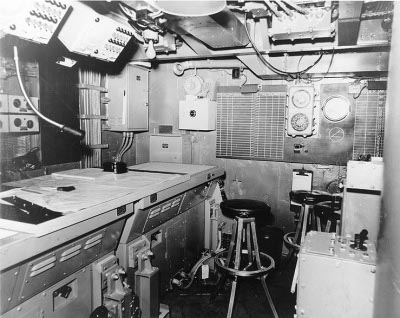![]() The Pacific War Online Encyclopedia
The Pacific War Online Encyclopedia
|
| Previous: Combat Fatigue | Table of Contents | Next: Comfort Class, U.S. Hospital Ships |

National
Archives
#80-G-120074
The combat information center, or CIC, was an important American innovation during the war. Its adoption was largely driven by technology, particularly radar, that produced a flood of potentially highly valuable information, if it could be correlated and displayed in a way useful to the commander. It was a relatively easy step from a radar room to a full-fledged information center, and by the end of the war even destroyers were being equipped with CICs. The Japanese had nothing like them and they provided a crucial advantage to American fighter direction and fleet control.
The CIC likely had its origin in Britain's Royal Navy,
which
took pains to provide adequate space in the flag bridge of its
flagships and to establish effective procedures for tracking information needed for the
admiral to make his
decisions. A
British liaison officer with Fletcher
at the Battle of Midway, CDR
Michael Laing, unobtrusively took notes on the layout and
management of
Fletcher's flag bridge and made a number of suggestions to Nimitz after returning
to Pearl Harbor. These
included the
use of the British system of lettered grid coordinates for secure
reporting of positions.
The need for better shipboard facilities for command and control was already obvious to many naval officers, and Nimitz issued Tactical Bulletin 4TB-42 on Thanksgiving Day, 1942, calling for establishment of a Combat Operations Center on every warship. King was profoundly impressed with the concept, but renamed it the Combat Information Center after discussion with other Navy chiefs in a conference on 8 January 1943. Critical facilities and components were identified, and Mahlon S. Tisdale became the driving force behind implementation
King's staff determined that the CIC should have at least four plots, for navigation, for air contacts, for surface contacts, and for fighter direction. The CIC required extensive interior communications, bearing indicators, TBS, PPIs, and timers, and King insisted that it be designed with 30% extra space for future expansion. The space was divided up so that current information was provided by radar and sonar scopes along the aft bulkhead, plots and status boards were along the forward bulkhead, and the port and starboard sides were devoted to aircraft or to surface and submarine contacts. Tisdale published a CIC Handbook for Destroyers on 24 June 1943, but Nimitz saw to it that this was distributed throughout the fleet. Eventually destroyer CICs were manned by fifteen sailors and CICs on larger ships by up to twice that number.
The Navy already had a Fighter Director School at Pearl Harbor, but this was renamed the Fighter Director and Combat Information Center School and expanded to train personnel for all aspects of CIC duty. This proved a serious bottleneck, with over a quarter even of carefully vetted students failing the demanding course. Additional training facilities were set up on the West Coast and CIC training became a part of every ship's predeployment workup.
The concept of the CIC had its most severe test off of Okinawa against the kamikaze raids. Here
the CICs were judged to have performed well, and the high cost of
the campaign arose from other weaknesses of American air defense
and from the effectiveness of the kamikaze concept. CICs
remain the brain center of warships today.
References
Naval History and Heritage Command (accessed 2010-4-30)
The Pacific War Online Encyclopedia © 2010, 2015 by Kent G. Budge. Index